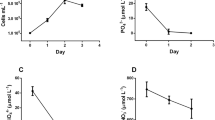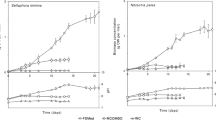Abstract
Artificial media are used in physiological studies of microalgae to maintain consistent conditions from one experiment to another and these media must be adapted to the needs of the organism studied. The artificial medium, in this case named diatom artificial medium (DAM), was designed to maintain long-term cultures of Haslea ostrearia and 19 other planktonic microalgae, and to allow physiological studies related to metal metabolism. The biomass and biochemical composition of H. ostrearia grown in the DAM and in a modified Provasoli medium were compared to assess the suitability of this new artificial medium for the culture of this diatom. The DAM provided sufficient nutrients to allow H. ostrearia to grow as efficiently as in the enriched seawater medium, without negative impact on metabolism. The DAM was tested with 19 other microalgae in order to widen its potential use, and 18 of the 19 showed a good adaptation to this medium. The chemical speciation of metals (Cd, Cu, Pb, Zn) was assessed using a speciation mathematical model. The presence of EDTA resulted in the total complexation of the trace metals implying that they were present in a sole chemical species in the DAM.



Similar content being viewed by others
References
Ahner BA, Price NM, Morel FMM (1994) Phytochelatin production by marine phytoplankton at low free metal ion concentrations: laboratory studies and field data from Massachusetts Bay. Proc Natl Acad Sci USA 91:8433–8436
Berges JA, Franklin DJ, Harrison PJ (2001) Evolution of an ar1tificial seawater medium: improvements in enriched seawater, artificial water over the last two decades. J Phycol 37:1138–1145
Berland BR, Bonin DJ, Maestrini SY, Pointier JP (1973) Etude de la fertilité des eaux marines au moyen de tests biologiques effectués avec des cultures d’algues. III. Réponses de la diatomée Skeletonema costatum à différentes concentrations d’éléments nutritifs. Int Rev Ges Hydrobiol 58:401–416
Carvalho AP, Malcata FX (2000) Effect of culture media on production of polyunsaturated fatty acids by Pavlova lutheri. Cryptogam Algol 21:59–71
Dubois F, Gilles KA, Hamilton JK, Rebers PA, Smith F (1956) Colorimetric method for determination of sugar and related substances. Anal Chem 28:350–356
Fernando Q (1995) Metal speciation in environmental and biological systems. Environ Health Perspec 103:13–16
Florence TM (1982) The speciation of trace elements in waters. Talanta 29:345–364
Gonzalez JL, Dange C, Thouvenin B (2001a) Spéciation des contaminants métalliques en milieu estuarien: Intérêt de la modélisation et application au cadmium. Hydroecol Appl 13:37–55
Gonzalez JL, Thouvenin B, Dange C, Fiandrino A, Chiffoleau JF (2001b) Modelling of Cd speciation and dynamics in the Seine estuary (France). Estuaries 24:1041–1055
Guillard RRL, Ryther JH (1962) Studies of marine planktonic diatoms. I. Cyclotella nana Hustedt and Detonula confervacea (Cleve) Gran. Can J Microbiol 8:229–239
Guillard RRL (ed) (1982) Culture of phytoplankton for feeding marine invertebrates. Plenum Press, New York
Harrison PJ, Waters EE, Taylor FJR (1980) A broad spectrum artificial medium for coastal and open ocean phytoplankton. J Phycol 16:28–35
Jensen TE, Rachlin JW, Jani V, Warkentine B (1982) An X-ray energy dispersive study of cellular compartmentalization of lead and zinc in Chlorella saccharophila (Chlorophyta), Navicula incerta and Nitzschia closterium (Bacillariophyta). Environ Exp Bot 22:319–328
Kester DR, Duedall IW, Connors DN, Pytkowicz RM (1967) Preparation of artificial seawater. Limnol Oceanogr 12:176–179
Lane TW, Morel FMM (2000) Regulation of carbonic anhydrase expression by zinc, cobalt and carbon dioxide in the marine diatom Thalassiosira weissflogii. Plant Physiol 123:345–352
Laurier FJG, Cossa D, Gonzalez JL, Breviere E, Sarazin G (2003) Mercury transformations and exchanges in a high turbidity estuary: the role of organic matter and amorphous oxyhydroxides. Geochim Cosmochim Acta 67:3329–3345
Lebeau T, Gaudin P, Junter G-A, Mignot L, Robert J-M (2000) Continuous marennin production by agar-entrapped Haslea ostrearia using a tubular photobioreactor with internal illumination. Appl Microbiol Biotechnol 54:634–640
Lorenzen CJ (1967) Determination of chlorophyll and pheopigments: spectrophotometric equations. Limnol Oceanogr 12:343–346
Lowry GH, Rosebrough NJ, Faar AL, Randall RJ (1951) Protein measurement with the Folin phenol reagent. J Biol Chem 193:265–275
Moreau C (1996) Des eaux souterraines salées en Baie de Bourgneuf pour la production de microalgues en aquaculture : l’azote ammoniacal, le fer et le manganèse dissous, causes de la variabilité de la fertilité potentielle pour trois diatomées-tests. Université de Nantes, Thèse de doctorat
Morel FMM, Hering JG (eds) (1993) Principles and applications of aquatic chemistry. Wiley Interscience, New York
Morel FMM, Rueter JG, Anderson DM, Guillard RRL (1979) Aquil: a chemically defined phytoplankton culture medium for trace metals studies. J Phycol 15:135–141
Neuville D, Daste P (1971) Observation concernant la production de pigment bleu par la Diatomée Navicula ostrearia (Gaillon) Bory maintenue en culture unicellulaire sur un milieu synthétique. C r Acad Sci Paris (Ser. D) 272:2232–2234
Price NM, Morel FMM (1990) Cadmium and cobalt substitution for zinc in a marine diatom. Nature 344:658–660
Price NM, Harrison GI, Hering JG, Hudson RJ, Nirel PMV, Palenik B, Morel FMM (1988) Preparation and chemistry of the artificial algal culture medium Aquil. Biol Oceanogr 6:443–461
Provasoli L (1968) Media and prospect for the cultivation of marine algae. In: Watanabe A, Hattori A (eds) Cultures and collection of algae. Proc USA Japan Conf, Hakone, Sept. 1966. Jap Soc Plant Physiol 63–75
Provasoli I, McLaughlin JJA, Droop MR (1957) The development of artificial media for marine algae. Arch Mikrobiol 25:392–428
Ranson G (1937) Le verdissement des huîtres. Sciences 8:13–24
Reinfelder JR, Kraepiel AML, Morel FMM (2000) Unicellular C4 photosynthesis in a marine diatom. Nature 407:996–999
Robert J-M (1978) Variations biométriques de l’algue Navicula ostrearia Bory (Diatomée pennée) en culture. Bull Soc Phycol Fr 23:38–44
Robert J-M (1983) Fertilité des eaux des claires ostréicoles et verdissement: utilisation de l’azote par les diatomées dominantes. Thèse de Doctorat d’Etat es Sciences biologiques, Université de Nantes
Robert J-M, Morançais M, Pradier E, Mouget J-L, Tremblin G (2002) Extraction and quantitative analysis of the blue-green pigment "marennine" synthesized by the diatom Haslea ostrearia. J Appl Phycol 14:299–305
Stumm W, Morgan J J (eds) (1996) Aquatic chemistry. Chemical equilibria and rates in natural waters, 3rd edn. Wiley, New York
Tremblin G, Cannuel R, Mouget J-L, Rech M, Robert J-M (2000) Change in light quality due to a green pigment, marennine, released in oyster-ponds: effects on growth and photosynthesis in two diatoms, Haslea ostrearia and Skeletonema costatum. J Appl Phycol 12:557–566
Yan H, Pan G (2002) Toxicity and bioaccumulation of copper in three green microalgal species. Chemosphere 49:471–476
Yee D, Morel FMM (1996) In vivo substitution of zinc by cobalt in carbonic anhydrase of a marine diatom. Limnol Oceanogr 41:573–577
Acknowledgements
We would like to acknowledge the Region Pays de la Loire for the attribution of a fellowship to S. G.-M. Thanks are also due to J.-L. Mouget for our discussions and to J. Kojadinovic for the linguistic revision of the manuscript.
Author information
Authors and Affiliations
Corresponding author
Rights and permissions
About this article
Cite this article
Gagneux-Moreaux, S., Moreau, C., Gonzalez, JL. et al. Diatom artificial medium (DAM): a new artificial medium for the diatom Haslea ostrearia and other marine microalgae. J Appl Phycol 19, 549–556 (2007). https://doi.org/10.1007/s10811-007-9169-4
Received:
Accepted:
Published:
Issue Date:
DOI: https://doi.org/10.1007/s10811-007-9169-4




